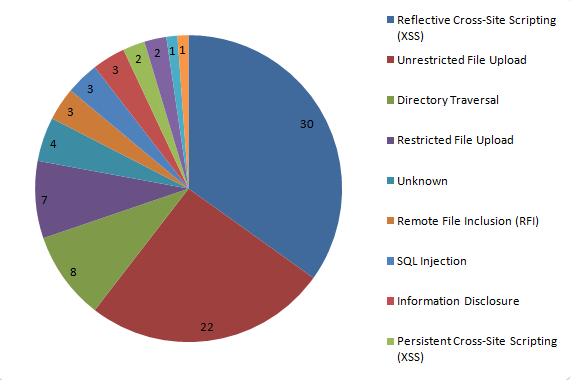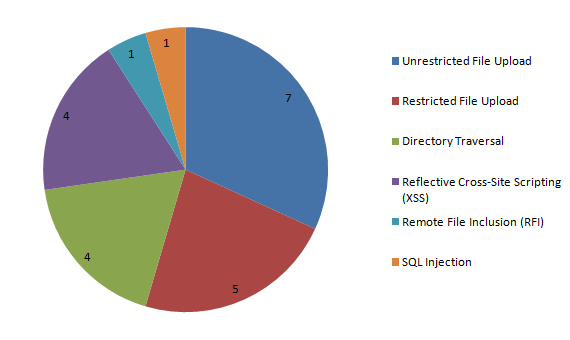As part of our continued focus on the problems related to the security of WordPress plugins, last month we compiled some statistics on plugin vulnerabilities found during the second quarter of 2012. As they might be useful to others we wanted to share them.
We used Secunia’s advisories for our data set as their advisories include vulnerabilities discovered by the developers of the plugins and those discovered by others, which provides a good mix of data. Secunia reviews the reported vulnerabilities so their advisories do not include false reports of vulnerabilities that we find in other sources of vulnerability data.
It is important to keep in mind that the vulnerabilities found are not necessarily representative of what vulnerabilities remain in plugins. A lot of what determines what vulnerabilities are found is what kind people happened to look for or find.
A few more quick notes on the data: we have excluded a plugin that was not ever available in the WordPress.org plugin directory, the data was generated on July 16, and the numbers in the charts do not correlate with each other as some plugins had multiple vulnerabilities.
This chart shows the breakdown of the types of vulnerabilities found in the plugins:
The largest percentage were reflective cross-site scripting (XSS) vulnerabilities, which, while serious, are not a kind of that are likely to be used in an targeted hack of a website so they are not a major concern. The second largest group of vulnerabilities was unrestricted file upload vulnerabilities. This type of vulnerability can be easily exploited to place backdoor script on a website, which a hacker can then use to do pretty much anything on the website. Some may be familiar with the TimThumb vulnerability, which was this type of vulnerability. That so many unrestricted file upload vulnerabilities were found is a good reminder of need for plugins with file upload capabilities to be carefully scrutinized to insure that plugins with this type of vulnerability are not available in the plugin directory.
This chart shows the number of plugins with vulnerabilities that have been fixed and not fixed:
That over a quarter of the plugins have not fixed is troubling, but even worse is the types of vulnerabilities in those plugins:
A third of those vulnerabilities are unrestricted file uploads. Not surprisingly due to the ease of exploitation and power granted, we have been seeing attempts to exploit the plugins found to have those vulnerabilities.
There is good news, plugins with unresolved security vulnerabilities are getting removed from the WordPress.org plugin directory, which had not always happened in the past. That is partly due to our making sure that plugins with unresolved security vulnerabilities are reported to the people maintaining the plugin directory, so that they get properly handled. Removing the plugins does not help when the plugin is already installed and that is why WordPress needs to provide alerts for removed plugins with unresolved security vulnerabilities. In the mean time you can use our plugin No Longer in Directory to check if you are using plugins that have been removed. If a removed plugin has a Secunia advisory that will be linked to in the plugin’s report.


